The Sun is a low-mass star on the outer reaches of our galaxy, the Milky Way. The Sun is about 30,000 light-years from the center of the Milky Way and lies at the edge of one of its spiral arms. At this distance, it takes about 250 million years to complete an orbit around the Galaxy. A light-year is the distance traveled by light in one year. One light-year is about 10,000 billion kilometers.
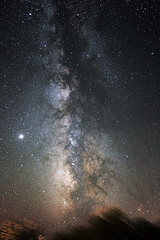
A photo of the Milky Way taken from Earth (image: pstanley).
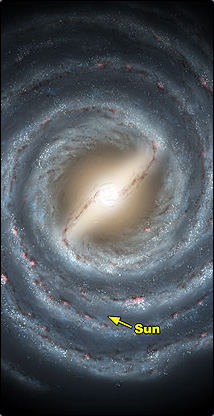
This artist's rendering shows a view of our own Milky Way Galaxy and its central bar as it might appear if viewed from above. An arrow indicates the location of our Sun.
Vital Stats
| |
Sun |
Earth |
Sun/Earth |
| Radius (km) |
696,000 |
6,376 |
109 |
| Mass (kg) |
2,000,000,000,000,000,
000,000,000,000,000 |
6,000,000,000,000,
000,000,000,000 |
333,000 |
| Volume (m³) |
1,400,000,000,000,
000,000,000,000,000 |
1,100,000,000,000,
000,000,000 |
1.3 million |
| Average density (g/cm³) |
1.40 |
5.506 |
1/4 |
| Surface gravity (m/s²) |
274 |
9.81 |
28 |
| Rotation period (days) |
26 (at equator) |
1 |
1/26 |
| Temperature at surface (K) |
~5700 |
~300 |
20 |
| Escape velocity at surface (km/hr) |
~2 million |
~40,000 |
~55 |
- Earth-Sun Distance: 150 million km (93 million miles)
- Elemental Composition of Sun: 74% Hydrogen, 25% Helium, 1% other (by mass).
- Solar Luminosity: ~ 4 x 1026 Watts. [As bright as 4 trillion trillion 100-watt light bulbs]
- Age of Sun: 4.6 billion years.
Much like the Earth, the Sun has many different layers that define its structure. Unlike the Earth, the Sun is completely gaseous, there is no solid surface on the Sun.
| Region |
Temperature |
Density |
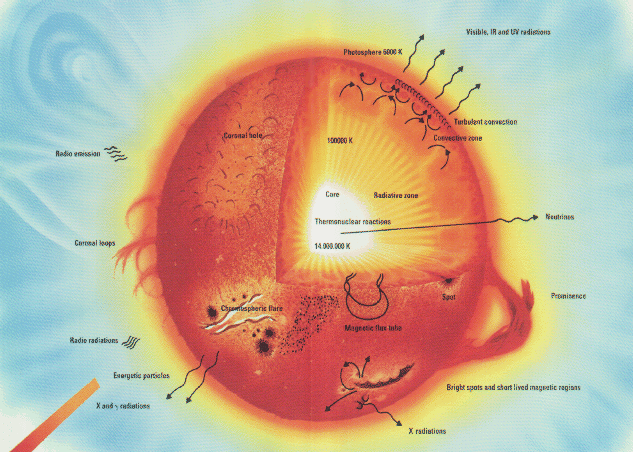 |
| Core |
15,000,000 |
150,000 |
| Radiation zone |
5,000,000-2,000,000 |
20,000-200 |
| Convection zone |
2,000,000-660,000 |
0.0002 |
| Surface |
5,700 |
0.0002 |
| Chromosphere |
6,000-20,000 |
0.0000000001 |
| Transition region |
20,000-1,000,000 |
0.00000000001 |
| Corona |
2,000,000 |
0.000000000001 |
| Temperatures are in degrees Kelvin and densities are in milligrams per cubic centimeter |
Activity
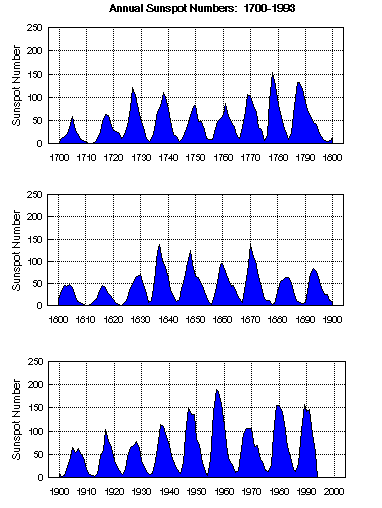 The Sun is a very active star. No matter when or where you look, the Sun is always doing something interesting. One of the most dramatic properties of the Sun's activity is the existence of a solar cycle, which is best seen in the pattern of sunspots. The graph to the left shows the behavior of the average number of sunspots over time for the last 300 years. We see from this figure that the number of sunspots on the Sun is not constant but varies significantly, with a peak number showing up approximately every 11 years.
The Sun is a very active star. No matter when or where you look, the Sun is always doing something interesting. One of the most dramatic properties of the Sun's activity is the existence of a solar cycle, which is best seen in the pattern of sunspots. The graph to the left shows the behavior of the average number of sunspots over time for the last 300 years. We see from this figure that the number of sunspots on the Sun is not constant but varies significantly, with a peak number showing up approximately every 11 years.
We are not exactly sure what causes this repeatable behavior, but processes deep inside the Sun generate its magnetic field, and may be responsible. Over the last 30 years, scientists have developed theories to explain this behavior, and observations from telescopes in space provide much needed information to help answer this solar mystery.
 An interesting pattern develops when we examine where on the Sun the sunspots appear. The figure on the left is known as a butterfly diagram, because the pattern looks like the wings of a butterfly. The figure shows the butterfly pattern for the last 11 solar cycles (each taking 11 years).
An interesting pattern develops when we examine where on the Sun the sunspots appear. The figure on the left is known as a butterfly diagram, because the pattern looks like the wings of a butterfly. The figure shows the butterfly pattern for the last 11 solar cycles (each taking 11 years).
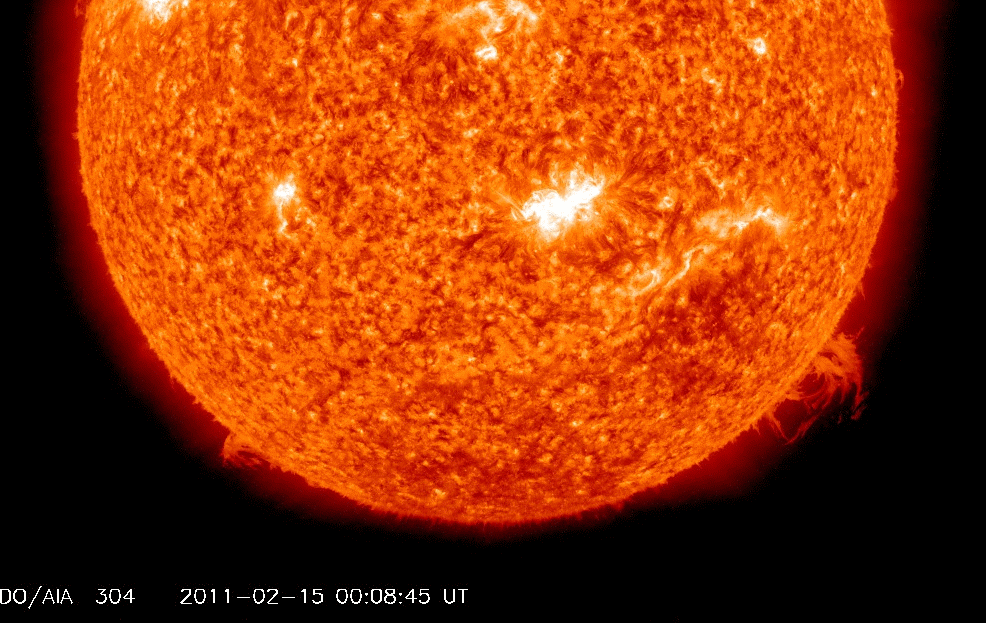 The vertical axis shows the latitude on the Sun which we measure just like on the Earth (equator is at 0, north pole is at 90N, south pole at 90S). This pattern tells us that at the beginning of a particular solar cycle, sunspots appear mostly at high latitudes (30N or 30S). As time goes on the sunspots appear nearer and nearer to the equator, until a new cycle begins and the process starts all over again.
The vertical axis shows the latitude on the Sun which we measure just like on the Earth (equator is at 0, north pole is at 90N, south pole at 90S). This pattern tells us that at the beginning of a particular solar cycle, sunspots appear mostly at high latitudes (30N or 30S). As time goes on the sunspots appear nearer and nearer to the equator, until a new cycle begins and the process starts all over again.
A more dramatic form of solar activity can be found in solar flares and coronal mass ejections. These are short-lived disruptions of the solar atmosphere which create fantastic displays in images of the Sun. Coronal mass ejections and flares are the solar causes of geomagnetic storms on Earth, which disrupt telecommunications, satellites and power grids.
Rotation
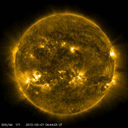 The Sun spins on its axis about once every 26 days. Because the Sun is made of gas, the rotation is quite different from that of a basketball spinning on your finger. Different parts of the Sun rotate at different speeds, with the fastest rotation rate occurring at the Sun's equator. The higher the latitude (north or south) the slower rotation. The Sun's polar regions have a rotation period greater than 30 days. This is known as differential rotation and is similar to the phenomenon which produces the distinct bands on the planet Jupiter.
The Sun spins on its axis about once every 26 days. Because the Sun is made of gas, the rotation is quite different from that of a basketball spinning on your finger. Different parts of the Sun rotate at different speeds, with the fastest rotation rate occurring at the Sun's equator. The higher the latitude (north or south) the slower rotation. The Sun's polar regions have a rotation period greater than 30 days. This is known as differential rotation and is similar to the phenomenon which produces the distinct bands on the planet Jupiter.
Evolution
It has often been said that the Sun is a fairly mediocre star in a fairly boring neighborhood of the Galaxy. This is true if you ignore the fact that the Sun is the only star we know of which supports life. However, it is still illustrative to compare the Sun with other stars in order to understand how stars form, evolve and eventually die. The Sun is about half way through its prime and will not change significantly as a star for another 5 billion years.
The basic stages in the Sun's life can be summarized as follows:
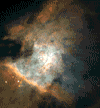 |
 |
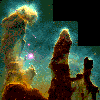 |
 |
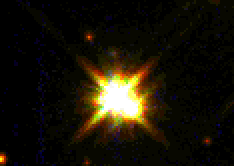 |
 |
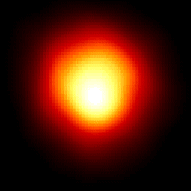 |
 |
| Gas cloud |
|
Proto-star |
|
Main sequence |
|
Red giant |
|
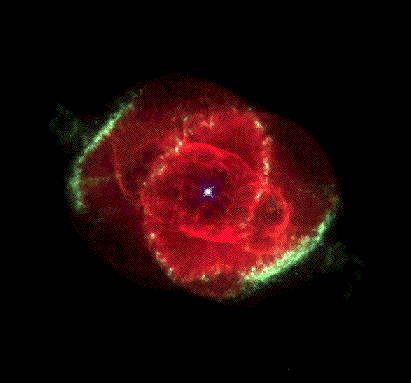 |
 |
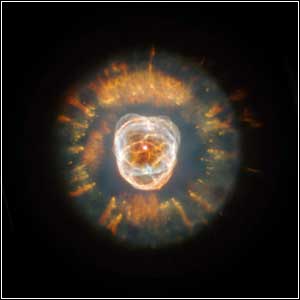 |
| Planetary nebula |
|
Remnant |
1. Gas cloud: Initially the gas and dust which go to make up stars is in the form of a large dense cloud that is relatively cold (temperatures around 10 degrees K, or, -440 degrees F). Parts of this gloud start to fragment and collapse under their own gravity to form blobs called proto-stars.
2. Proto-star: As the blob collapses it starts to heat up in its center (gravitational energy is being converted into heat). The proto-star gets hot enough to glow red (temperatures are around 2000-3000 K). The proto-star continues to condense until nuclear reactions in its core halt the gravitational collapse.
3. Main sequence: The star is stable, burning Hydrogen gas to Helium in its core through nuclear fusion. The energy released causes the star to shine. Stars spend about 90% of their active lifetime as main sequence stars.
4. Red giant: As the star runs out of core fuel to "burn" the stability of the star is disrupted and the core begins to shrink. The star then starts to turn Helium into Carbon, allowing it to "shine" for a while longer. The rapid burning of helium causes the outer layers of the star to puff out, cooling the star and causing it to glow red. It is now a red giant. Red giants can eject a lot of mass through "winds'." While a red giant may be much larger than the main sequence star from which it came, it has less mass. The Sun will spend approximately 250 million years as a red giant.
5. Planetary nebula: The outer layers of the star are ejected as core continues to shrink. For stars like the Sun, this process produces what is known as a planetary nebula (Strangely, these nebulae have nothing whatsoever to do with planets). A planetary nebula is defined as a shell of hot gas that has been expelled from a star going through its late stages of evolution. The material in the nebula comes from the outer layers of the star, leaving its core exposed.
6. Remnant: The low mass core continues shrinking to form a star known as a white dwarf surrounded by the planetary nebula.
The Sun is currently in its Main Sequence stage, where its spends most of its active life. About 90% of all stars are in this stage of their evolution.
Back to Today's topic